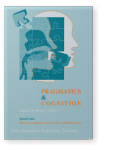Crosslinguistic paths of pragmatic development
The acquisition of actually and en fait by British and French children
Diachronic studies of discourse markers suggest they follow a unidirectional developmental path, from
propositional to textual and expressive uses. The present study tests whether children acquire the propositional (literal) before
the expressive (pragmatic) functions of two adversative discourse markers in French and English, which have similar core meanings
and pragmatic functions. Our results partially confirm the propositional-first hypothesis but semantics and pragmatics appear to
work together, rather than first one then the other, at least in this case, and this runs counter to both diachronic theories and
usage-based accounts of L1 acquisition. 88 occurrences of en fait and 174 of actually were
extracted from the CHILDES database, and coded for two functions (adversative and elaborative) and three domains (propositional,
textual, expressive). The results suggest that the pragmatic functions of actually are used by children as young
as two years old, but the same is not true of en fait, which is almost exclusively propositional in the early
years. By contrast, before age 5, French children start to use en fait for textual and elaborative functions to a
greater extent than actually. The role of syntactic position and parental input are discussed.
Article outline
- 1.Introduction
- 2.Background of the study
- 2.1Functions of actually and en fait in contemporary spoken British English and European
French
- 2.2
Actually and en fait in diachrony
- 2.3Child language acquisition of DMs
- 3.Methodology
- 4.Results
- 4.1First year of acquisition
- 4.2Case study: Development till age 5
- 4.3Analysis of input data
- 4.4Position and function across children and adult data
- 5.Conclusions
- Notes
-
References
